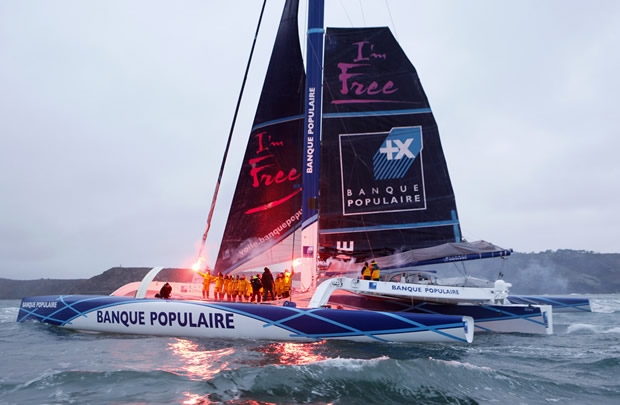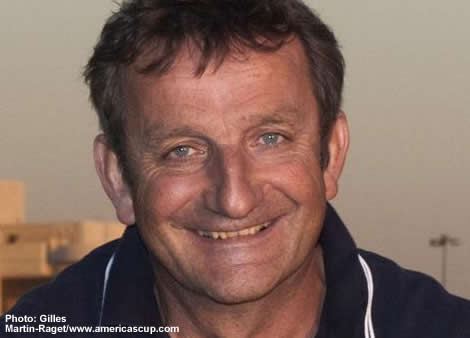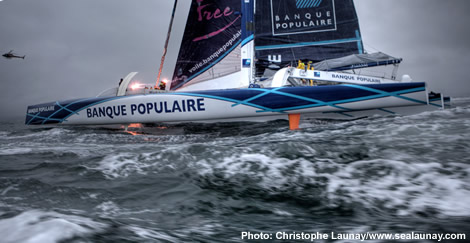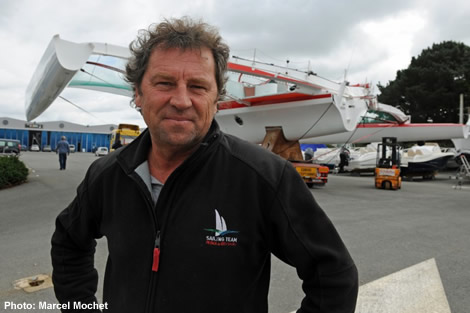
Where next for the maxi-multihulls?
With Banque Populaire successfully setting the new fastest time for the Jules Verne Trophy; the team unlikely to have another crack at bettering their present record; the 40m long trimaran conclusively proving she is the world’s fastest offshore race boat and no other competitors to her on the horizon...one wonders where the future for the fully crewed non-stop around the world record now lies?
In the short term it is most likely that the Jules Verne Trophy will only be bettered if someone buys Banque Populaire and sets sail with an equally experienced crew and hopes for a more favourable forecast and less ice in the Pacific. In the perfect scenario (which of course is unlikely to ever happen), the feeling is that the present boat could get the Jules Verne Trophy time down to 40-41 days. Impressively, that would be approaching half the time Bruno Peyron and the crew of Commodore Explorer, the first Jules Verne Trophy holders, took in 1993.
With Banque Populaire now five years old (six in design terms), we asked Vincent Lauriot Prevost of Banque Populaire’s designers VPLP how a state of the art 2012 generation maxi-tri might differ and whether it would be bigger? Prevost says that bigger is one option, but this is just one of many performance-defining factors in a maxi-tri, including beam, mast height, sail area, but particularly - something which all these factors play a part in - righting moment.

“Up to now we know from this experience [Banque Populaire] that we are able to cope with something like a 260 tonne metre boat and we made a step forward compared with Groupama 3 which was less than 200,” says Lauriot Prevost. It should be remembered that Banque Populaire is substantially longer than Groupama 3, at 40m compared to 32m, but has only 0.5m more beam. Significantly she also has longer wave piercing bows and more buoyancy forward.
Under Jules Verne Trophy rules the use of stored power for handling sails is not permitted, so the scale of these boats is effectively limited by what a crew of human beings can physically handle. However Lauriot Prevost notes that it is easy enough to get around this with purchase systems and points to the jib sheets which were 1:1 on Groupama 3, but 2:1 on Banque Populaire. In fact this has even allowed them some safety margin in the loads involved with the winches.
With racing multihull design, the most intriguing relationship is that between weight, robustness of the structure and gear, and how hard a crew can drive their boat.
In terms of robustness, a maxi-multihull like Banque Populaire shares with IMOCA 60s the requirement to be able to make it around the world non-stop. This is significant - imagine how different a Volvo Ocean Race boat would be if the ability to refit it in each stopover was removed...
Then there is the compromise between engineering and building a stronger, heavier, boat that a crew could push harder versus a lighter boat which they would more frequently have to back off... "Our perception – and it is the same as for an IMOCA boat – is that the boat should be the most powerful for minimum weight,” says Lauriot Prevost. “If you are too heavy you have to always be in the higher range of sails, in the higher range of everything and you fatigue the materials. And the boat doesn’t accelerate as well as it does when it is lighter. So the weight of boat is a big concern for us during the design.”
Lauriot Prevost says this was not the case with Oracle’s 33rd America’s Cup winning wingsail trimaran USA17, where righting moment was increasing by raising mast height and enlarging the foils, at the expense of extra weight. “The VPP says that the more powerful you are, the faster you are – always – for monohulls and multihulls, but then you have to be able to exploit that righting moment and on a boat like Banque Populaire on the Jules Verne you are never flying a hull, so it is not that same approach as it was on a boat like USA 17, which had to fly a hull upwind and downwind in the lightest wind speeds.”
This is similar to the argument over whether a heavier more powerful IMOCA 60 with a big bulb and more righting moment (a la Pindar/Hugo Boss) has the performance edge over one which is lighter but has a smaller bulb and less righting moment. In the computer the former is faster, but to date it has been the latter genre which has mostly won out on the race course.
Where the similarity with an IMOCA 60 ends (apart from the number of hulls) is that the Jules Verne Trophy maxi-multihull has a full crew and is constantly being driven to a higher percentage of its polars.

“On the Jules Verne we are under the polars for sure,” says Lauriot Prevost. “But I think on the transatlantic record we were at 100%. Then the boat was much more around 38 knots of speed whereas on the Jules Verne they stayed on 32-34 knots, because they sailed the boat conservatively to get around the world about too much breakage.”
On boats which can’t always be pushed to the max for fear of breakage, this understanding of ‘where the limit is’ is crucial and on Banque Populaire it seems to have been partly down to 'feel' and partly 'physics'. The seat of the pants element came from the considerable experience among crew, with several having previously sailed multiple multihull laps of the planet (such as Fred le Peutrec who was on Groupama 3 and Club Med or Brian Thompson who was on Cheyenne and Doha 2006), while for the more scientific there was the readings from the load cells attached to the forestay, shrouds and winches. This was a more basic load cell arrangement than that fitted on the 33rd AC multihulls, for example, without the sonic alarms...
“They know the bracket where they can use the boat, but you have to have alarms on a boat like this,” says Lauriot Prevost. “You can’t just say ‘it looks like a bit too much’. You have to have numbers I think.”
While the approach of Banque Populaire’s designers, both at VPLP and within the team, was meticulous, Lauriot Prevost says it still falls way short of the kind of resource found within an AC team like Oracle where there is more opportunity, manpower, time and money, to carry out ‘projects’, investigating different areas of the boat down to the last minutae and then developing them.
AC
VPLP has been part of America’s Cup Race Management’s group of designers, engineers and specialists that created the off-the-shelf AC72 design package teams can acquire if they are ‘running late’ with their funding. It seems all, with the exception of the big three – Oracle, Artemis and Emirates Team New Zealand - currently fall in this category (if they are to get funding at all) and while latecomer Luna Rossa has partnered with the Kiwis, allegedly, just one ACRM design package has been sold and the buyer is......Oracle.
“For ourselves it is a bit frustrating because we’d rather be working for a challenger,” says Lauriot Prevost. They worked on the design package from October 2010 through until August last year but obviously a new team buying the package at this stage will lack the development work the bigger teams will have had the opportunity to carry out.
“The more time is passing, the more we know that there won’t be time for a team, even if they buy the package, to develop it. We would like something to happen,” says Lauriot Prevost. “You still have time to build a boat, but you won’t have time to build a boat you know.”

Other multihulls
While there are no more maxi-multihull new builds on the horizon, VPLP do have another large multihull they are working on in the form of Thomas Coville’s former Sodebo ORMA 60 trimaran, recently been sold to Route du Rhum winner Lionel Lemonchois and his Prince de Bretagne campaign.
This is to undergo a similar enlargement to the metamorphosis of Gitana 11 from ORMA 60 to 77 footer for the last Route du Rhum. However while Baron Rothschild’s boat had her hulls enlarged, the new Prince de Bretagne is to have three all-new hulls extending her LOA to 80ft. Sodebo's crossbeams (she was the beamiest of the ORMA 60s, wider than she was long), rig and appendages are to be reused.
The hull moulds are in the process of being built at Multiplast in Vannes and the shells themselves will be laminated in February with a view to launching the completed boat in the summer. “If you do it like this, you have the freedom to put the beams where you want and the mast. You can rearrange the platform,” explains Lauriot Prevost.
Unlike Gitana 11, Banque Populaire and the Irens/Cabaret singlehanded maxi-tris IDEC and Sodebo, the new Prince de Bretagne won’t have a centre hull longer than the floats. “We have to satisfy a weight estimate which allows us to take all the old parts so we have to be in the same range of righting moment,” says Lauriot Prevost. Plus the longer centre hull increases wetted surface area.
The new trimaran is destined for the 2014 Route du Rhum and so will be an ‘Atlantic’ boat. Lauriot Prevost says that her freeboard will be a little more than that of the MOD70s. The weight of the boat is expected to be around 7 tonnes.










Latest Comments
Add a comment - Members log in